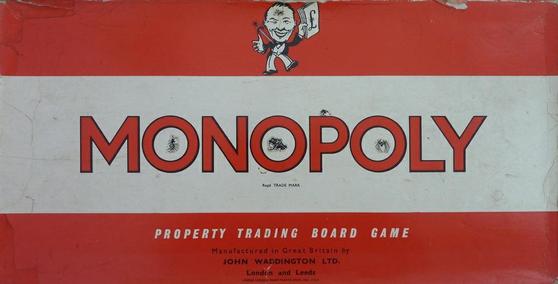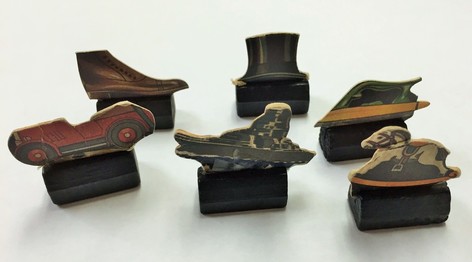WWII Era Monopoly Game Pieces
Monopoly was originally a game created in 1903 by anti-monopolist Elizabeth J. Magie Phillips that she used as a way to help explain the economic theories of Henry George. From 1906 through the 1930s, a series of variant board games based on her concept called “The Landlord’s Game” were developed that involved buying, selling, and developing land. In 1935, Parker Brothers, an American toy and game manufacturer, began selling a variation of “The Landlord’s Game” which they titled “Monopoly”. Since that time, Monopoly has become popular throughout much of the world, and has been licensed in over 100 countries and printed in multiple languages.
One of the more interesting aspects of Monopoly’s history occurred during World War II. An intelligence office with the British Directorate of Military Intelligence, Section 9 (MI9) named Christopher Clayton Hutton (nicknamed Clutty) had an inspiration to conceal escape kit tools in a game, which he believed the Germans would allow into their POW camps. He was already familiar with the company of John Waddington, Ltd, who had perfected the ability to print on durable silk, and the company was printing escape maps for MI9 that were sewn into airmen’s uniforms in the event they were shot down over enemy territory. He was also aware that John Waddington, Ltd was the licensed manufacturer of the popular Monopoly board game, and came up with the idea of concealing multiple escape kit items within the game board that could be used by allied prisoners of war to aid in their escape from German POW camps. Hutton approached John Waddington, Ltd and asked that a special version of the game be developed.
A secret department consisting of just a few employees was established at the game manufacturer to construct the special game sets. Silk maps, a small compass, a wire saw and a file were hidden in shallow recesses cut into the board before the paper gameboard decal was glued on, making it impossible to tell apart from a normal game board. In addition to the items concealed within the game board, they placed real money within the stacks of play money.
Once the escape kit versions of the game had been manufactured, MI9 created a number of fake charities that they used as cover organizations to send the games to the prisoner of war camps. It is unknown how many POW’s escaped using the Monopoly escape kits, but it was successful, and as a testament to the method of using the game as a means of concealment for the escape tools, it is important to note that the Germans never caught onto the ruse.
My collection includes a set of game pieces from a Monopoly game manufactured during World War II. Due to supply constraints during the war, the game was altered to use a spinner as a substitute for the dice, and the game pieces were replaced by simple wood and cardboard pieces. The game pieces in my collection are not from one of the escape kit game sets, which were all destroyed by POW’s after removal of the escape tools to prevent discovery by the Nazis, but it does represent the game pieces from the era.
One of the more interesting aspects of Monopoly’s history occurred during World War II. An intelligence office with the British Directorate of Military Intelligence, Section 9 (MI9) named Christopher Clayton Hutton (nicknamed Clutty) had an inspiration to conceal escape kit tools in a game, which he believed the Germans would allow into their POW camps. He was already familiar with the company of John Waddington, Ltd, who had perfected the ability to print on durable silk, and the company was printing escape maps for MI9 that were sewn into airmen’s uniforms in the event they were shot down over enemy territory. He was also aware that John Waddington, Ltd was the licensed manufacturer of the popular Monopoly board game, and came up with the idea of concealing multiple escape kit items within the game board that could be used by allied prisoners of war to aid in their escape from German POW camps. Hutton approached John Waddington, Ltd and asked that a special version of the game be developed.
A secret department consisting of just a few employees was established at the game manufacturer to construct the special game sets. Silk maps, a small compass, a wire saw and a file were hidden in shallow recesses cut into the board before the paper gameboard decal was glued on, making it impossible to tell apart from a normal game board. In addition to the items concealed within the game board, they placed real money within the stacks of play money.
Once the escape kit versions of the game had been manufactured, MI9 created a number of fake charities that they used as cover organizations to send the games to the prisoner of war camps. It is unknown how many POW’s escaped using the Monopoly escape kits, but it was successful, and as a testament to the method of using the game as a means of concealment for the escape tools, it is important to note that the Germans never caught onto the ruse.
My collection includes a set of game pieces from a Monopoly game manufactured during World War II. Due to supply constraints during the war, the game was altered to use a spinner as a substitute for the dice, and the game pieces were replaced by simple wood and cardboard pieces. The game pieces in my collection are not from one of the escape kit game sets, which were all destroyed by POW’s after removal of the escape tools to prevent discovery by the Nazis, but it does represent the game pieces from the era.

